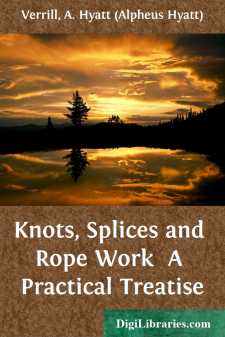Categories
- Antiques & Collectibles 13
- Architecture 36
- Art 48
- Bibles 22
- Biography & Autobiography 813
- Body, Mind & Spirit 142
- Business & Economics 28
- Children's Books 16
- Children's Fiction 13
- Computers 4
- Cooking 94
- Crafts & Hobbies 4
- Drama 346
- Education 46
- Family & Relationships 57
- Fiction 11829
- Games 19
- Gardening 17
- Health & Fitness 34
- History 1377
- House & Home 1
- Humor 147
- Juvenile Fiction 1873
- Juvenile Nonfiction 202
- Language Arts & Disciplines 88
- Law 16
- Literary Collections 686
- Literary Criticism 179
- Mathematics 13
- Medical 41
- Music 40
- Nature 179
- Non-Classifiable 1768
- Performing Arts 7
- Periodicals 1453
- Philosophy 64
- Photography 2
- Poetry 896
- Political Science 203
- Psychology 42
- Reference 154
- Religion 513
- Science 126
- Self-Help 84
- Social Science 81
- Sports & Recreation 34
- Study Aids 3
- Technology & Engineering 59
- Transportation 23
- Travel 463
- True Crime 29
Knots, Splices and Rope Work A Practical Treatise
Categories:
Description:
Excerpt
INTRODUCTION
The history of ropes and knots is so dim and ancient that really little is known of their origin. That earliest man used cordage of some kind and by his ingenuity succeeded in tying the material together, is indisputable, for the most ancient carvings and decorations of prehistoric man show knots in several forms. Doubtless the trailing vines and plants first suggested ropes to human beings; and it is quite probable that these same vines, in their various twistings and twinings, gave man his first idea of knots.
Since the earliest times knots have been everywhere interwoven with human affairs; jugglers have used them in their tricks; they have become almost a part of many occupations and trades, while in song and story they have become the symbol of steadfastness and strength.
Few realize the importance that knots and cordage have played in the world's history, but if it had not been for these simple and every-day things, which as a rule are given far too little consideration, the human race could never have developed beyond savages. Indeed, I am not sure but it would be safe to state that the real difference between civilized and savage man consists largely in the knowledge of knots and rope work. No cloth could be woven, no net or seine knitted, no bow strung and no craft sailed on lake or sea without numerous knots and proper lines or ropes; and Columbus himself would have been far more handicapped without knots than without a compass.
History abounds with mention of knots, and in the eighth book of "Odyssey" Ulysses is represented as securing various articles of raiment by a rope fastened in a "knot closed with Circean art"; and as further proof of the prominence the ancients gave to knots the famous Gordian Knot may be mentioned. Probably no one will ever learn just how this fabulous knot was tied, and like many modern knots it was doubtless far easier for Alexander to cut it than to untie it.
The old sorcerers used knots in various ways, and the witches of Lapland sold sailors so-called "Wind Knots," which were untied by the sailors when they desired a particular wind. Even modern conjurors and wizards use knots extensively in their exhibitions and upon the accuracy and manner in which their knots are tied depends the success of their tricks.
In heraldry many knots have been used as symbols and badges and many old Coats of Arms bear intricate and handsome knots, or entwined ropes, emblazoned upon them.
As to the utility of knots and rope work there can be no question. A little knowledge of knots has saved many a life in storm and wreck, and if every one knew how to quickly and securely tie a knot there would be far fewer casualties in hotel and similar fires. In a thousand ways and times a knowledge of rope and knots is useful and many times necessary. Many an accident has occurred through a knot or splice being improperly formed, and even in tying an ordinary bundle or "roping" a trunk or box few people tie a knot that is secure and yet readily undone and quickly made....


